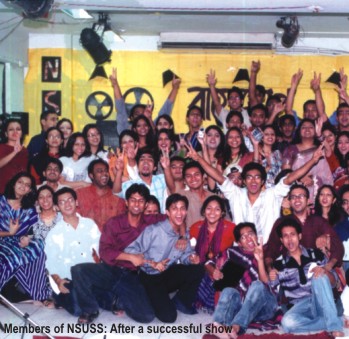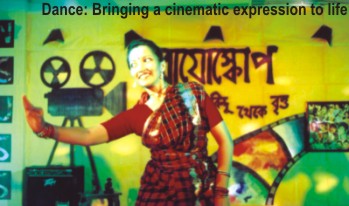|
Cinema
Celebrating 50 years of Cinema
Elita Karim
Going to the movies or the cinema was something I would read about in books, where people in love spend time with each other. My first ever experience of the cinema was in 1995, when my cousins took me to watch Lion King and Batman Forever in some mall in London. The massive screen and the splendid sound overwhelmed me so much, that I hardly noticed my little cousin licking his fingers to the last of my buttery popcorn and savouring the last sip of my coke. I could not help wondering as to how the people on the screen came to life and how their very emotions could be felt by me, and, I am sure, by every other person with a ticket. Of course, now with the Cineplex at Bashundhara City Complex, many have had similar experiences, though with very limited movies.
It is common knowledge amongst many young people like me, that we have always been discouraged to go to the local cinemas in our country and that too for good enough reasons. Along with the cinema's ludicrously distasteful representation of the concepts of life shelled in the plots, details such as set design, costume, make-up and the basic characterisation of the hero, heroine and the villain are, as always, preposterous. This is apparent from the many 'film-posters' plastered on the city walls. The equally unpleasant social environment within the cinema hall also prevent cinema lovers from going to the movies.
 Nevertheless, the Bangladeshi cinema has completed 50 years. North South University Sangskritik Sangathan (NSUSS) recently organised a one-and-a-half-hour programme where the members highlighted the major developments of Bangladeshi cinema. "Surprisingly enough," says Ryan Proshun Perris, president of NSUSS, "Bangla cinema was at its best in the earlier years. Not only was it rich in terms of idea formation and characterisation but also music and choreography.' It is sad that one cannot say the same for the movies being produced today. Nevertheless, the Bangladeshi cinema has completed 50 years. North South University Sangskritik Sangathan (NSUSS) recently organised a one-and-a-half-hour programme where the members highlighted the major developments of Bangladeshi cinema. "Surprisingly enough," says Ryan Proshun Perris, president of NSUSS, "Bangla cinema was at its best in the earlier years. Not only was it rich in terms of idea formation and characterisation but also music and choreography.' It is sad that one cannot say the same for the movies being produced today.
NSUSS, a cultural club of North South University, regularly organises artistic and cultural events on campus and the Annual Cultural Evening (ACE), which every one looks forward to."We have great talents in our country," informs Masudul Amin Rintu, the General Secretary of the club. "Since culture represents and speaks for its respective country, it is our duty to preserve the cultural aspects of our country, including cinema, one of our many creative excellences."
The programme, titled "Bioscope: Bindu theke Britto" showcased a number of clips from famous Bangladeshi movies, ranging from the early years to the 1990's, namely, Mukh o Manush, Nawab Siraj-ud-Dawlah, Nayan Tara, Etotuku Asha and many more. The programme was designed in such a way that aspects from each era in Bangladeshi cinema were highlighted on. The first actual cinema filmed and made in India was, in fact, a Bangali named Hiralal Sen, born in Manikganj, Dhaka.
 "If we go back to the history of our own Liberation War and further back to 1952, the year of the Language Movement, we see that the then East Pakistanis were becoming aware of the beauty and the richness of Bangla and the freedom to express in their own language," says Rezwan Razzak Monty, a senior member of the club. However, even back then the local cinema halls in our part of the world used to play host to foreign cinema and culture, which the Bangalis clearly and obviously enjoyed and entertained themselves with. "The authorities had also declared our cinema and other expressions of culture degrading for society," he adds. "That was when Abdul Jabbar Khan proved them wrong with his Mukh o Manush, in 1956, the first Bangla film in the then east Pakistan." "If we go back to the history of our own Liberation War and further back to 1952, the year of the Language Movement, we see that the then East Pakistanis were becoming aware of the beauty and the richness of Bangla and the freedom to express in their own language," says Rezwan Razzak Monty, a senior member of the club. However, even back then the local cinema halls in our part of the world used to play host to foreign cinema and culture, which the Bangalis clearly and obviously enjoyed and entertained themselves with. "The authorities had also declared our cinema and other expressions of culture degrading for society," he adds. "That was when Abdul Jabbar Khan proved them wrong with his Mukh o Manush, in 1956, the first Bangla film in the then east Pakistan."
The audience, filled with students and teachers, enjoyed thoroughly the representations of cinema through the many expressions and creations by the members of NSUSS. Age-old songs and popular tracks like Tumi ki dekhecho kobhu, Aynate ey mukh, O dada bhai, She je keno elo na, Hayre manush rongin fanush, Amar buker modhekhane, Amar bhanga ghorer and Chupichupi bolo keu jene jabe were revived on stage by the students. Besides film songs, a dances number on the catchy Shaluk shaluk jhiler jale and poem "Hulia" brought out the other aspects underlining cinema as a whole.
Unexpectedly, a puthi path was a major attention--graffer, retelling the story of Prophet Ibrahim, his attempt of sacrificing his son as per the commands made by Allah and also the emotions of a silent mother, crying within despite her strong urge to follow God's orders.
 "Bioscope:Bindo theke Britto" was a show that involved a lot of research into the realms of Bangladeshi cinema. "It was something that took a lot of work, but had to be done within a very short time span," says Taiseer Zaman, treasurer of the club and also chair of the particular in-house show. "Our students actually spent a lot of time after classes, in between their exams to build a decent set and also to run around the city to gather relevant information." NSUSS had collected a number of film posters from different production houses in the city and also reproduced the movie clips, courtesy Dipen from Channel i's 'Amar Chobi'. "Bioscope:Bindo theke Britto" was a show that involved a lot of research into the realms of Bangladeshi cinema. "It was something that took a lot of work, but had to be done within a very short time span," says Taiseer Zaman, treasurer of the club and also chair of the particular in-house show. "Our students actually spent a lot of time after classes, in between their exams to build a decent set and also to run around the city to gather relevant information." NSUSS had collected a number of film posters from different production houses in the city and also reproduced the movie clips, courtesy Dipen from Channel i's 'Amar Chobi'.
In spite of the growing contempt against commercial cinema in Bangladesh, this bunch of young people seems to have a positive attitude towards 'reel-life'. "It's getting better," says Ashraf ul Haque Bhuiyan, vice-president of NSUSS. "Quality movies like Chaka, Matir Moyna, Joy Jatra are proof enough that we do have producers in the country who like to bring out the elements in cinema that a normal and average movie-goer would enjoy.
Copyright
(R) thedailystar.net 2005
|
